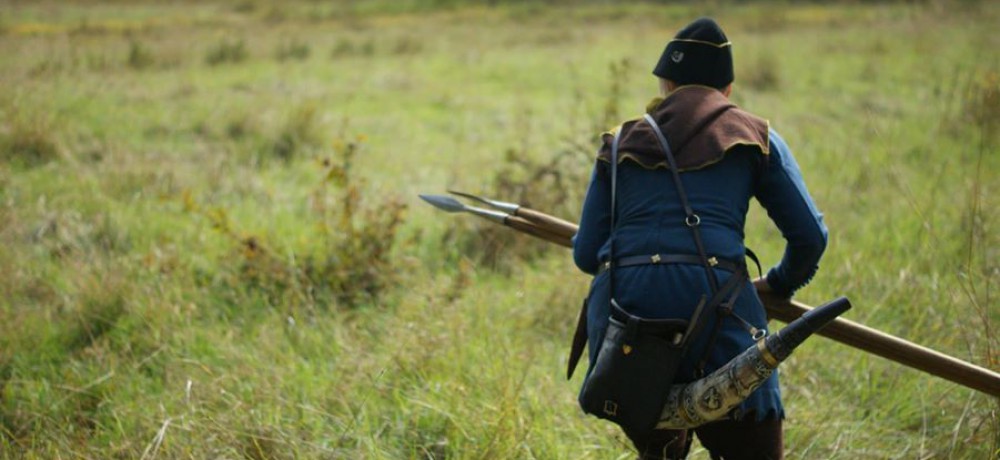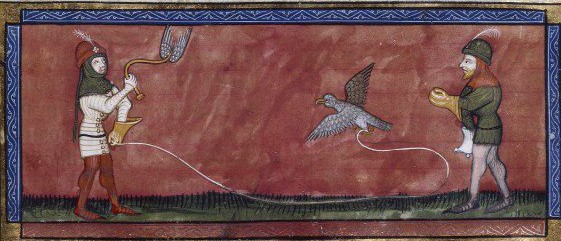I and other reenactors often get questions about how we find information, period pictures for inspiration and if there are evidence in the archaeological material for this or that. This is a huge topic, I’m learning still and I cannot possibly cover it with a single post. But I’d like to share some of my thoughts on it, in order to help you answer the recurring question “Can I wear this?” yourself.
Reenactment is about recreating things as close as we can get to the real thing. I believe it is really important to do your best to achieve that. For me this ambition is what makes it challenging but also fun and rewarding. To get as close to the real thing as possible with your medieval gear, you’ll need to start in the right end. Even if an attempt to research may feel intimidating for beginners, it is much easier to first look for proof among period pictures, in historical sources, contemporary art and archaeological material rather than the other way around.
If you first decide what you want, make it or buy it and afterwards try to find proof that things were actually done that way – you are bound to be disappointed. Working that way is an anachronism based on how you decide what you next fashion item will be in your modern everyday wardrobe. Especially as a beginner at reenactment you need to free yourself of this mindset or you risk finding yourself in lack of evidence and thus have to abandon your project or re-do it.

“Can I wear this?” This illumination from Les livres du roi Modus is my main source of inspiration for my next outfit.
However, finding information and evaluating it is a craft in it self. You have to have some feel for period art expression, knowledge about the geography, religious life, economy, politics and social strata of the society you are studying just to formulate a question. It helps a lot if you have some understanding for medieval crafts and materials, their value and production.
As I hope you understand, it is not possible for anyone to be an expert on all of this at once. That is why we have professional historians, archaeologists and art specialists. I’ve read my share of history and archaeology but it is in no way sufficient to make me an expert. That is why we need our friends, other blogs, museums and a living network of historical enthusiasts. On the left here in our blog you’ll find a list of links to some of the resources we use for inspiration and information.
The best tool for learning is a healthy combination of curiosity and scepticism. In time, you’ll build up a bank of experience and a reference material among period texts and pictures, it does not come over night. So start to nose around, ask others, visit museums, look at pictures and read, but keep up a sound sceptical approach. Never stop questioning what others say, what you see and what you think you know. Anyone can be mistaken, misinterpretations of old are still around and new ones are discovered all the time.
But then how are you ever to know if a source is reliable, if something is appropriate to recreate and right for you? I’ll give you an example of the process of trying to finding out. Let’s say that I’d like to make a new bag for my hunting outfit. I’ve been looking around for a picture to base my bag on and I’ve finally found one. This white little purse, doesn’t it seem excellent for carrying my phone while I’m out hunting? And it appears in a handbook on hunting, Les livres du roi Modus et de la reine Ratio from late 14th century. Perfect!
Or is it? What is actually happening on the picture…? They are fighting! Some of you will recognize the scene from Johans post about the conflict that seems to have been between hunters and falconers. There was bad blood between falconers and hunters about which was the noblest and most true kind of hunt – that with birds of prey or that with dogs. The bird-like thingy on the whipping piece of string is a decoy for training falcons, a tool for falconers. Here the hunters are portrayed with horns and the falconers are the ones wearing the little white bags.
What I want to say is this – you’ll need an idea of what you are reenacting, who you are in the medieval world and society in order to know what equipment you’ll need. Are you a hunter or a falconer, or in other words – a dogturd or fleapicker? If there is a conflict between hunters and falconers during the time you are reenacting and you want to be a hunter – don’t wear a falconers bag.
You’ll want to be sure to use the right attributes signalling who you are. You should aim for everything to go together in your ensemble of gear. Ask yourself – are you reenacting a man or a woman, poor or rich? When and where? What are your privileges in society and how do you express them? Where do you imagine that the person you are portraying live? What tools or characteristics are typical for your trade?
As I lift my eyes from the first picture of the purse I soon find that the little white bag perhaps could be attributed to falconers to set them apart from hunters. In Les livres du roi Modus et de la reine Ratio only falconers seem to wear them. Why is this? Interesting!
Could it be that his type of bag is signalling the falconer’s trade in illustrations or has some sort of special use for a falconer? Such a hypothesis calls for further investigation. If I’m right, it makes this bag inappropriate for me to wear as a hunter. But in order to start calling this a falconers bag, I’d have to have stronger proof. I’d like to see the connection in other manuscripts as well or have some other attribution of the little white bag to this specific use. But once you start looking, you’ll see little white bags everywhere…

The fact that not only falconers are wearing little white bags does not contravene the hypothesis that falconers maybe did as a mark of their trade. What I need is proof from other manuscripts or sources that show falconers carrying the same type of bag. The more pictures or historical evidence, the stronger the connection is.
Here is one from Codex Manesse, early 14th century.  I’d prefer to have support from at the least three different manuscripts or other sources roughly from the same period of time before I conclude anything or decide to make something new. As I only have pictures from two sources and because Les livres du roi Modus is late 14th century and Codex Manesse is early, I’ll either have to keep looking or accept that my hypothesis is invalid.
I’d prefer to have support from at the least three different manuscripts or other sources roughly from the same period of time before I conclude anything or decide to make something new. As I only have pictures from two sources and because Les livres du roi Modus is late 14th century and Codex Manesse is early, I’ll either have to keep looking or accept that my hypothesis is invalid.
When I started looking around in other sources, I got curious about what the falconers use the bag for. Knowing that could help me find more information and puzzle the pieces together. The little I know about falconering makes me wonder if it could be a easy-access-bag with meaty treats for the falcons? Little purses are commonly pictured in period illuminations and plenty of them are preserved, but they are rarely white. Why is this bag always white? Could it be a bag of linnen? I know that flax is hard to dye with period methods but very suitable to proof with wax and as such for storage of fresh food.
Mind you, it is not always possible to tell what material it is supposed to be just by looking at a picture. Also, don’t settle with a single picture of a funny looking bag found in just one manuscript before you decide to make one just like it, unless you are in to recreating that single scene exactly as it is. Ask yourself what the context tells you – the text that your picture illuminates, if you can read it or have it translated – what is it about? Does this type of bag occur anywhere else? Release your curiosity, start to ask and look around!
 Here for instance is a picture of another bag or purse. It is not of the same type as the one I’m looking for but it is a good example of problems you’ll run into as a reenactor. Can I consider a bag like this one for my medieval hunters outfit?
Here for instance is a picture of another bag or purse. It is not of the same type as the one I’m looking for but it is a good example of problems you’ll run into as a reenactor. Can I consider a bag like this one for my medieval hunters outfit?
Notice how big it is, almost like a modern backpack. From this period of time, mid- to late 14th century I know not of any others like it in size. Why is that? I haven’t seen everything, so I had to ask others who are more experienced. When I did, I was told that the text that this illumination belongs to is about the trouble that meets a man courting ungrateful and greedy women. Then I notice that the lady has a grumpy frown upon her face. I see the rejecting hand gesture and her very fancy dresses. I guess that she is not happy with her lovers gift, it is not good enough for her. How ever large and valuable, it is not what she wants from him.
From other texts and pictures as well as from interpreting the motifs on purses from the 14th century, aumônières, or alms purses seems to have been common gifts between lovers. I conclude that it is possible that the purse above is pictured as a large one in order to emphasize its importance, illustrating the great generosity of this man courting his ungrateful lady. Enlarging the most important thing in a picture is a common technique in contemporary art during this time but it can be misleading for us who look at the pictures some 650 years later…
To sum things up – as I am reenacting a 14th century hunter, none of the bags in my examples so far seems to be entirely appropriate. I’m still looking for something suitable, but I hope that sharing my searching strategy can be of help for others.
You will not always find what you are looking for and that is my last tip to you, don’t be to sure that you will. Don’t jump to conclusions to soon, look around, compare pictures from different sources and read the texts that go with the illuminations. Question what you think you know and try to see the bigger picture. As you do, you’ll get more skilled at analysing period art and you’ll learn more about the medieval world.
Good luck!
/ Emil







Reblogged this on Cardiff Castle Garrison and commented:
Great post for anyone in medieval re-enactment wondering whether an item is appropriate for them.
Great!
we are happy you found something of use-
Pingback: Warm, dry and happy. | Exploring the medieval hunt